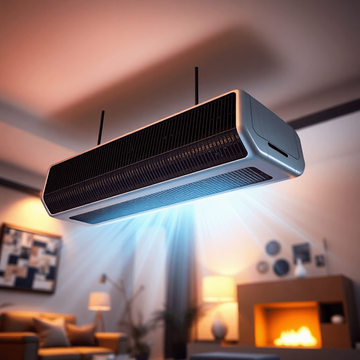Built in thermostat Vs Non thermostat - What to choose?
Our Infrared bar heaters are the best sellers when it comes to choosing the right heater for larger spaces where more powerful heat and higher wattage is required. They are perfect for warehouses, churches, hall spaces as well as residential conservatories and kitchens where space for a heater can be a issue.
However, when it comes to choosing whether to have one with built in thermostat and non thermostat heaters, we always get asked by our clients why they should choose one over the other. Let's delve into the key differences and advantages to help you make an informed decision.
Thermostat Control
While both options have wifi control, meaning they can both be controlled from your mobile phone app, Non-thermostat infrared bar heaters stand out for their ability to be managed all at once through a single thermostat.(Our smart thermostat hardwired to the non remote heaters mean you can have wifi control) This means that you can control all the heaters from the thermostat, which is perfect for larger areas where you require more than a few of the bar heaters. Instead of adjusting each heater individually which you need to do for the built in thermostats, you can set and maintain the desired temperature seamlessly from one centralised control. This approach ensures uniform heating, which is vital for maintaining comfort in large environments such as warehouses, event halls, and expansive office spaces.
On the other hand, the built in thermostat bar heaters are ideal for spaces where only one or a few of the heaters are required, for example a conservatory or a office room where only one heater is required. They are also more suited where you wish to zone the heating, for example at workstations in warehouses, where you may have a few heaters, however you don't need them on all at once, as only specific areas are used on given days. This means you can switch on just the heaters required rather then switching them all on at once through a centralised approach
Efficiency
Centralised control offered by non-thermostat heaters enhances operational efficiency. By having a single thermostat to monitor and adjust multiple heaters, the system can prevent overheating or underheating specific areas within the space. This not only optimises energy consumption but also ensures consistent heating performance throughout the area. In commercial settings, where energy costs can be significant, this efficiency translates into tangible savings over time.
However, with a built in thermostat, you can also reduce energy consumption by only using heaters that are required to be on, rather then switch them all on at once through the centralised control. Perfect again for zoned spaces, where not all heaters are required to be on all the time as only certain areas are being used
Ease of Use and Maintenance
Managing multiple heaters with built in thermostats can be a headache, especially in large spaces where you would have to switch each heater on individually, or even ensuring all the heaters are switched off at the end of the day. Non-thermostat heaters simplify this task by having one control which would switch them all on or off with the press of a button on your phone through the smart thermostat app, or even controlling the temperature, and setting daily timers.
Cost-Effectiveness
Built in thermostat heaters are generally more cost effective to install and operate, simply because they can be plug and play. They often come at a higher initial cost of each unit, but do not require any complex wiring setups. On the other hand, the non thermostat heaters are cheaper to buy, however they would need hardwiring all back to on thermostat control. this means additional costs of installing. They can also be plug and play without wiring to a thermostat, but this would mean you would have to manually switch each one on/off from a switch and there would be no temperature control or timer control. We always highly recommend having a thermostat with any heating unit you install
Built-in Thermostat Vs Non-Thermostat Heaters: Making the Choice
While heaters with built-in thermostats offer localised control, which may be advantageous for smaller, or zoned areas, they can become impractical and difficult to manage in larger spaces, however they are perfect for areas where you wish to control each heater individually. In contrast, non-thermostat heaters hard wired to a central thermostat provide a streamlined approach to temperature management. This eliminates the time consuming task associated with managing multiple units individually, ensuring hassle-free operation and reliable performance, especially in workplaces where staff can sometimes forget to switch heating off. With the central control, you can remotely switch them all off by the press of a button
Conclusion
When deciding between built-in thermostat heaters and non-thermostat heaters for heating large spaces, the choice ultimately depends on your specific needs and requirements. For larger spaces where more heaters are required and a uniform temperature, then the centralise approach is ideal. On the other hand, built in thermostat infrared bar heaters emerge as a practical and efficient solution, for those areas where you would like to zone heating and switch individual heaters off when not required
Explore our range of heaters:
Next steps: choose the right infrared heating
Continue with one of these popular options:
- Shop All Panels, accessories & bundles.
- Wattage Calculator Get the right watts for your room.
- How Infrared Works Benefits, costs & installation.






